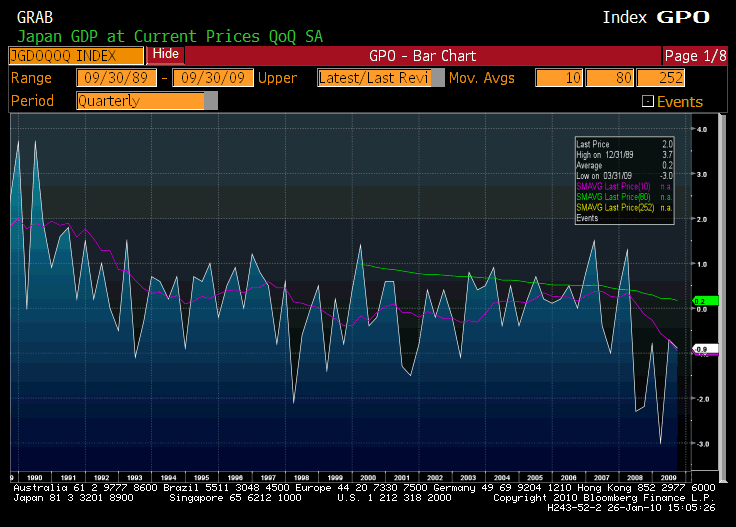My Visit to the US Treasury, Part 7 (Final)
Things have been busy for me, so this final part should be short.? What did I learn that I did not already know?? Not much, except:
- The Treasury wants to convince? the public that it is doing its best, but that Congress is a slave to the Financial Services industries.
- When asked about the latest bailout of GMAC, they said that didn’t qualify as a financial — the aid was to help the auto companies.? (If so, send it directly, and let GMAC expire.)
- They said that they worried about the same things we did, though they had to maintain public confidence, and did not think it was as likely as we thought.
- They did not bring up the GSEs.
- They pointed at the financial markets as evidence of recovery, and did not speak of the real economy, which is weak.
- There is no acknowledgment of what could go wrong in the long-run.? They are only playing for the next 3-7 years, at most.? Everything is done to goose the next year.
- That the Treasury is trying to reduce its footprint in the economy is welcome news to me.
- They said that they were trying to be wise stewards of the economy, but that Congress had questionable motives.
May I go back to my original questions:
- Haven?t low interest rates boosted speculation and not the real economy?
- We are looking at big deficits for the next seven years, but what happens when the flows from Social Security begin to reverse seven years out?? What is your long-term plan for the solvency of the United States?
- We talk about a strong dollar policy, but we flood the rest of the world with dollar claims.? How can we have a strong dollar?
- None of your policies has moved to reduce the culture of leverage.? How will you reduce total leverage in the US?
- Why did you sacrifice public trust that the Treasury would be equitable, in order to bail out private entities at the holding company [level]?? People now believe that in a crisis, the government takes from the prudent to reward the foolish.? Why should the prudent back such a government?
- If we had to do bailouts, why did we bail out financial holding companies, which are not systemically important, instead of their systemically critical subsidiaries?
- We are discussing giving tools to regulators for the tighter management of the solvency of financials.? There were tools for managing solvency in the past that went unused.? Why should we believe the new ?stronger? tools will be used when the older tools weren?t used to their full capacity?? (The banks push back hard.)
I’ve answered 1 and 2.? The rest are unanswered.? Here are the brief answers.
3) No, there is no strong dollar policy.? Wait for the day when we are net exporters (and our relative wages will be lower then.)
4) They are doing nothing to? reduce total leverage in the US.? My own guess is that it is increasing.
5) And there is the question, aside from fairness, were the bailouts Constitutional?? A narrow reading of the Constitution says no, but our government does many, many things that violate a narrow reading of the Constitution.? The fairness question was not raised either, the bloggers there were attacking effectiveness, not fairness.
6) This is my guess — we bailed out holding companies because it was the simplest way to do it.? More thought would have led to a cheaper solution, but thought is rare during a panic.
7) I have no answer to point 7.? There is no good reason to hand over stronger tools to a culture that has not used weaker tools.
Aside from all that, we could have spent more time on international issues.? There was the joke at the beginning of the session that one fellow tasked with raising money was “fluent in Mandarin.”?? From the chuckles, I gauged it to be a joke.
But that might prove to be the most significant point economically.? The Treasury is putting pressure on the Dollar through high debt issuance, and the Fed through the creation of short-term credit to heal various debt markets.? The benefits are going to debtors, not creditors.? What value should the creditors assign to the Dollar?? The simple answer should be less than previously.? Yet, nations follow many noneconomic goals, many of which benefit the US as the reserve currency in the short-run.
The ultimate answers are complex, because they rely on how other nations will act.
Final Note
I have found interesting the commenters that automatically assume that being willing to go to the Treasury and eat one cookie equals compromise.? There are a lot of scared and frustrated people in the US, and they see their prosperity ebbing, and are looking for someone to blame.
Let me try this — as the world has gone capitalist, the edge of the US has been eroded.? Now we face a world where doing certain jobe should pay the same, regardless of where they are located.? Wages in the US will converge with those from the rest of the world, adjusted for capital investments.
Throughout human history, “middle classes” have been abnormal.? The current adjustment in the US may be showing the once large middle class that it is not a normal thing, and is hard to maintain.
There is no conspiracy.? The US Government is up against economic forces larger than it can combat.? The rest of the world is out-competing the US, and the US? has a shrinking portion of the pie as a result.





